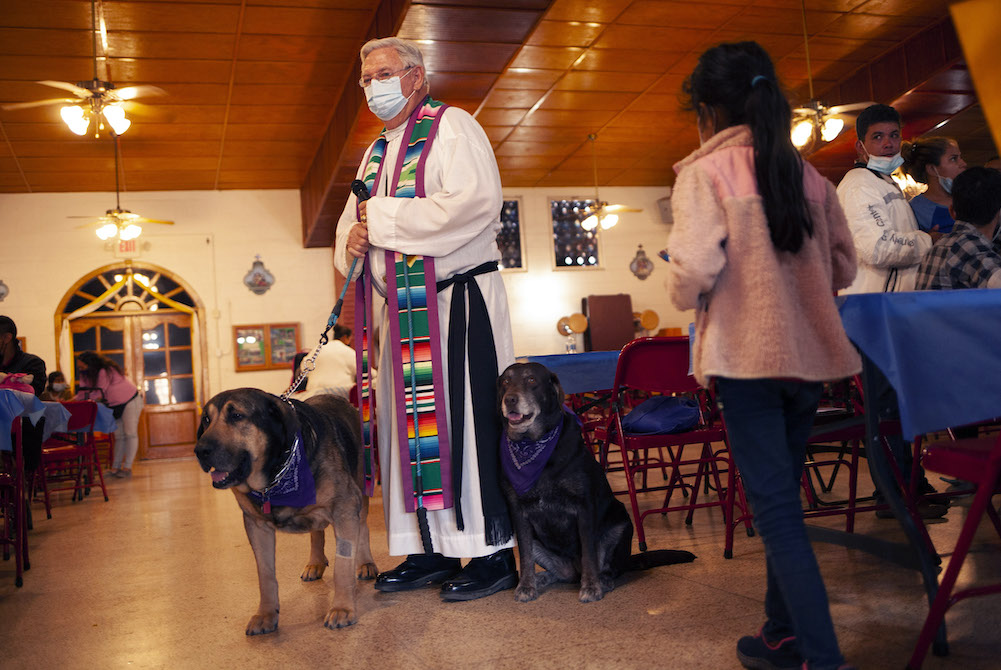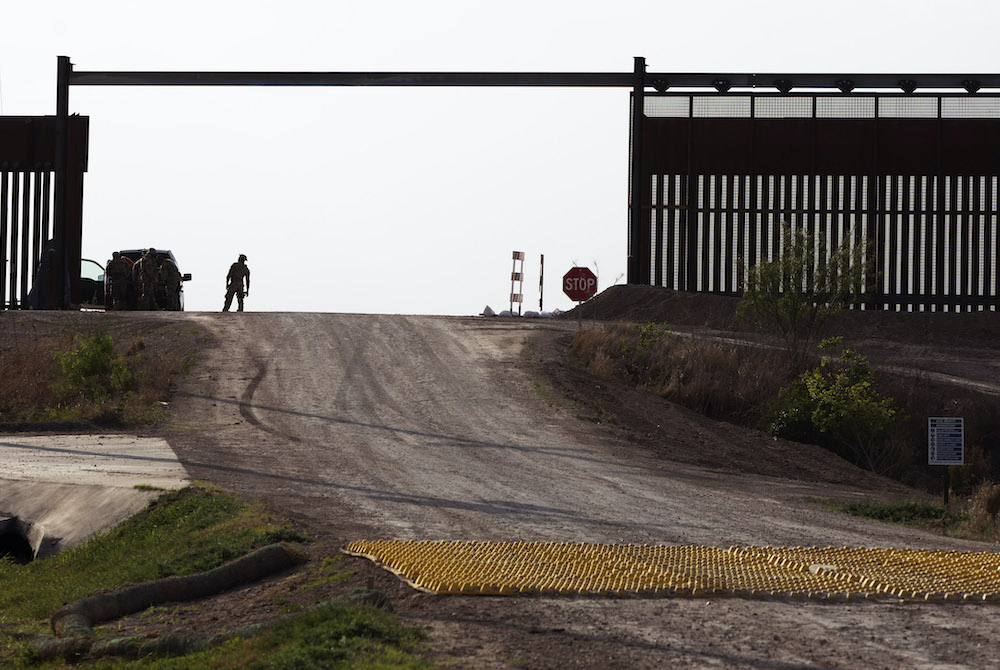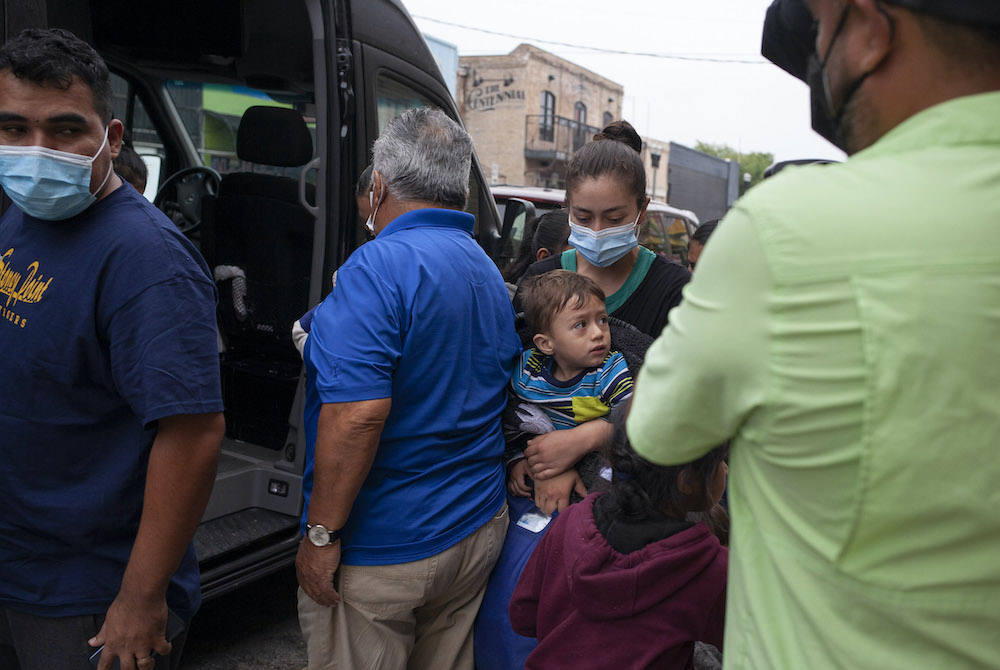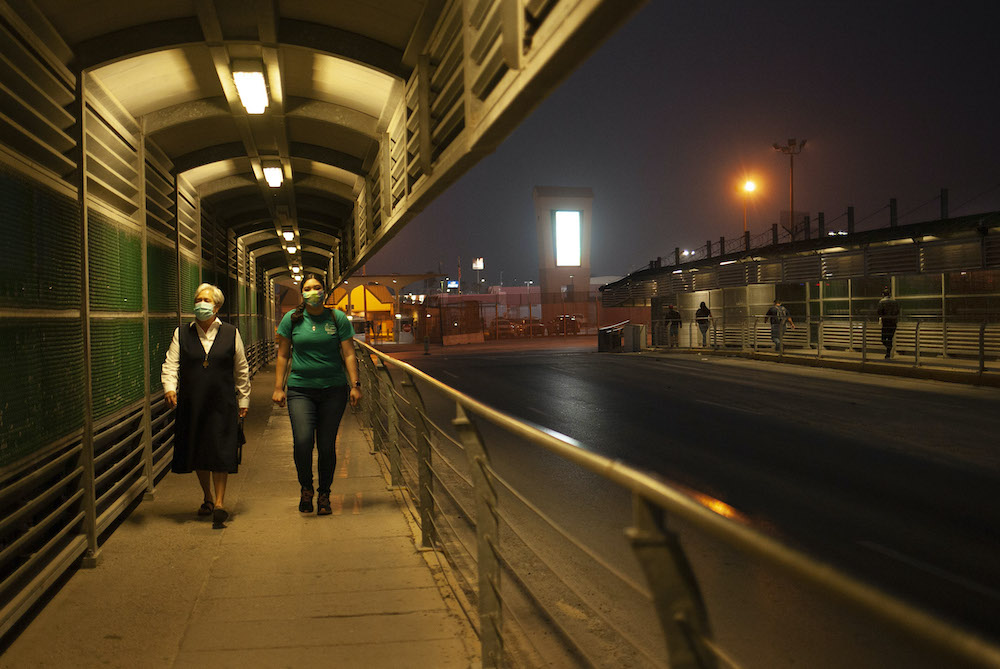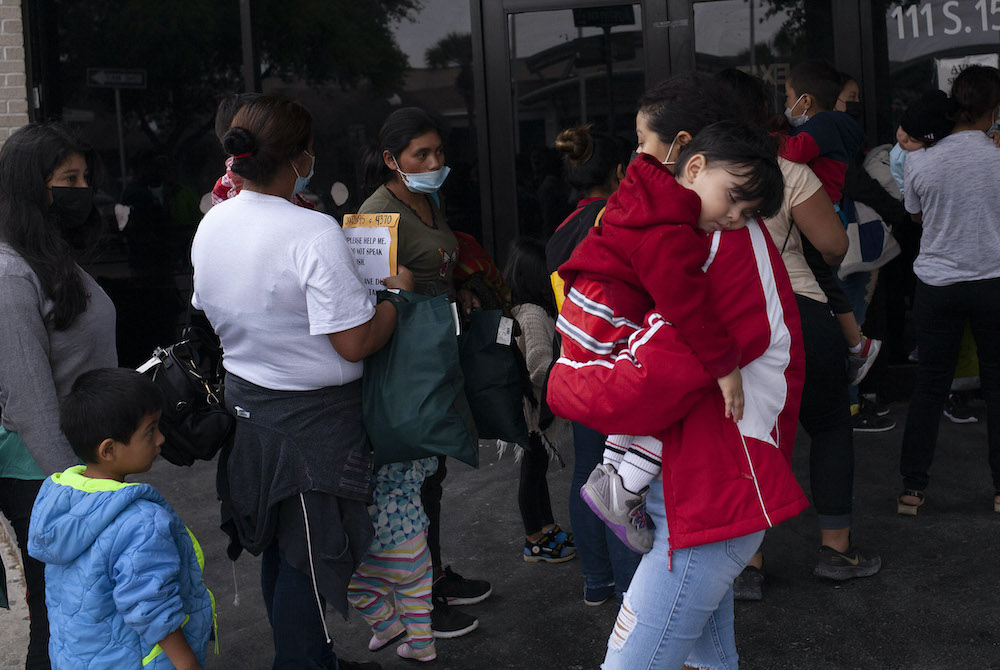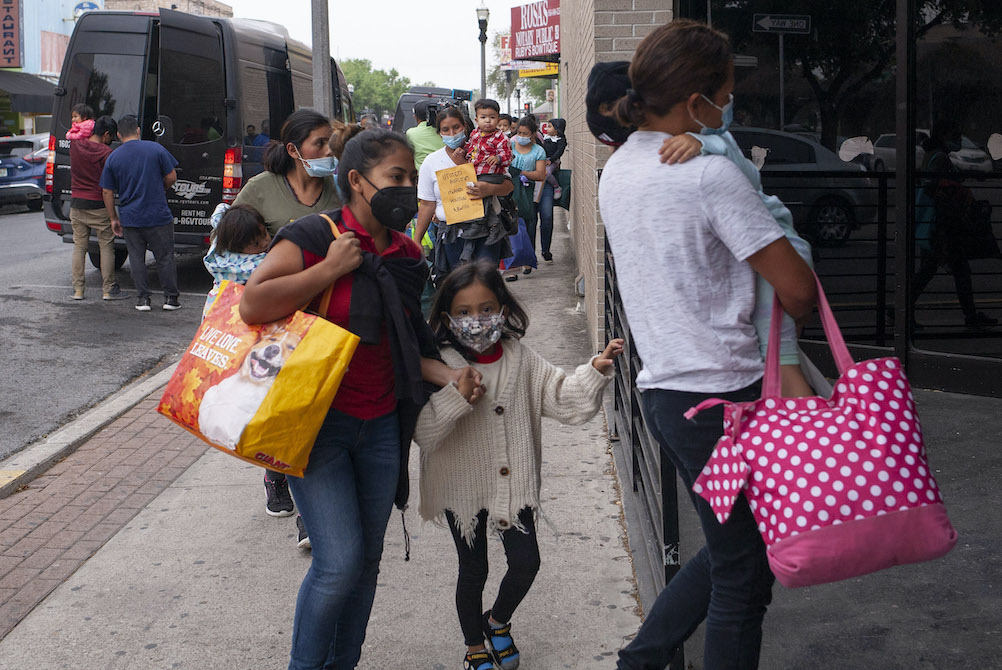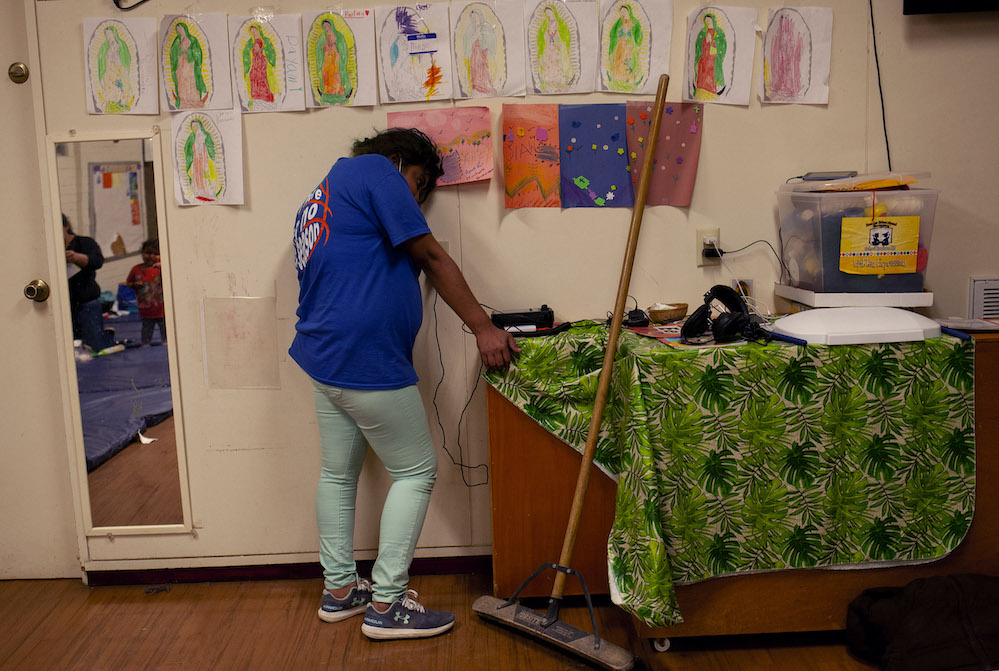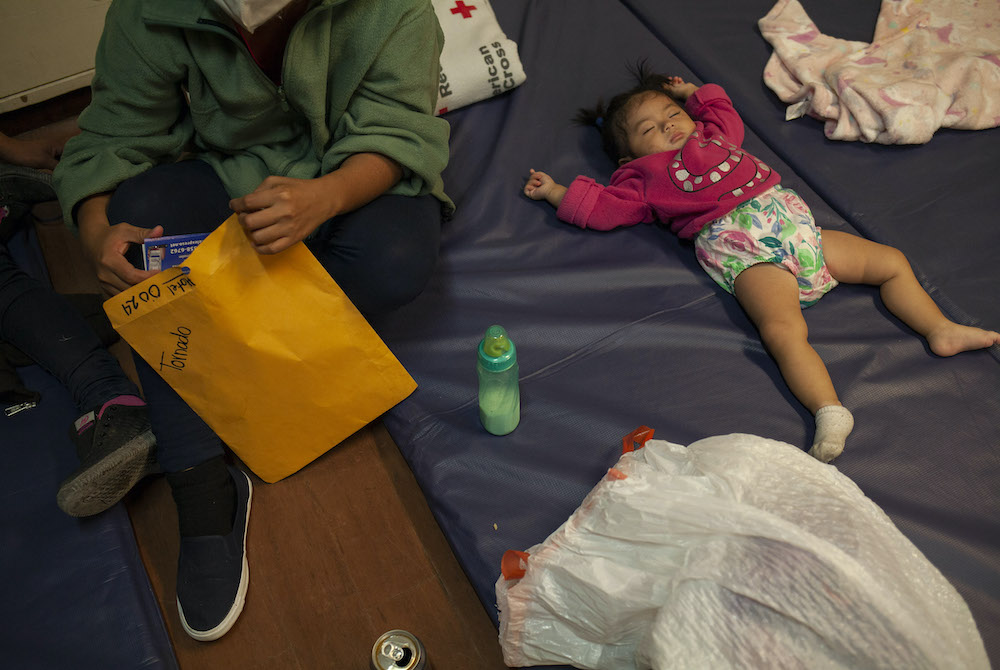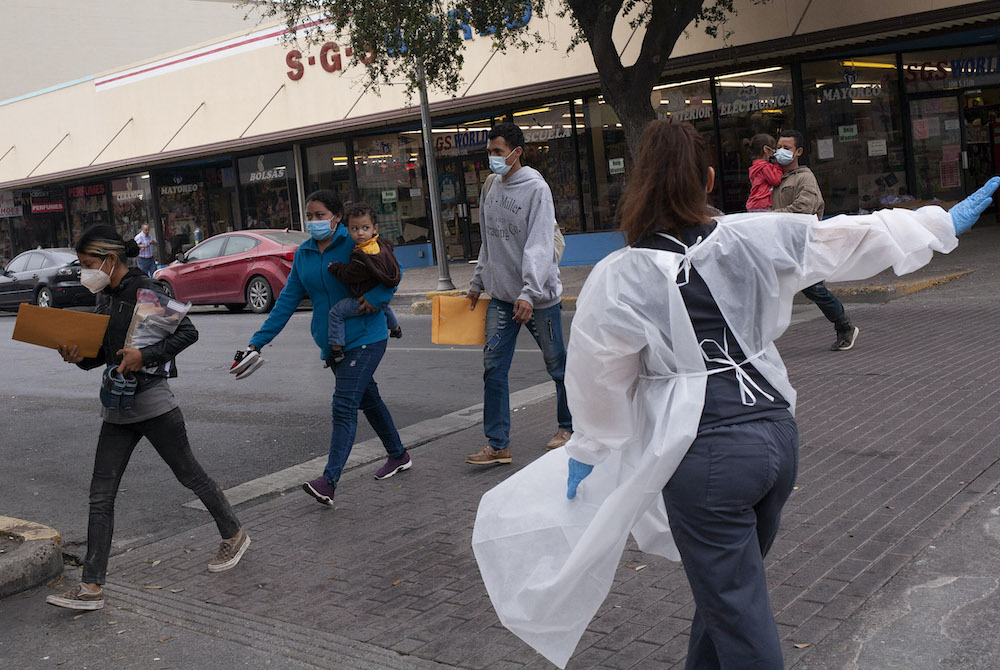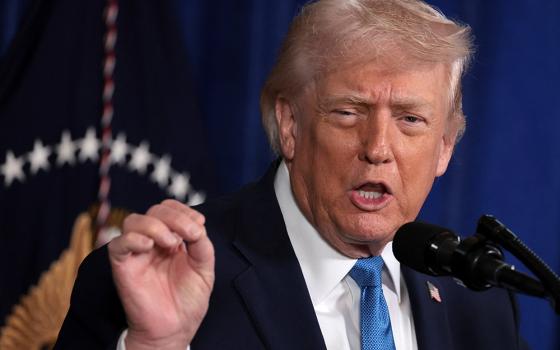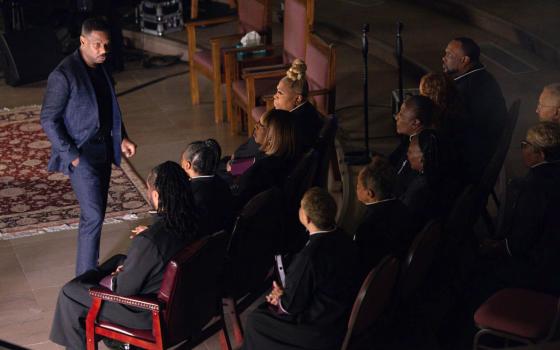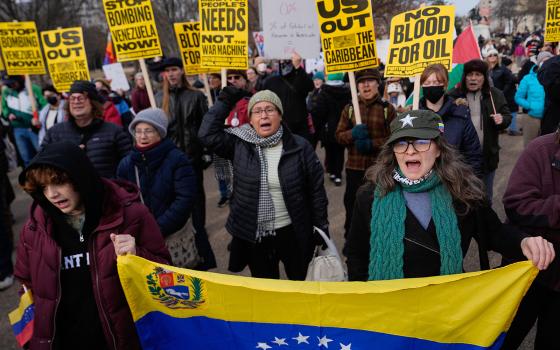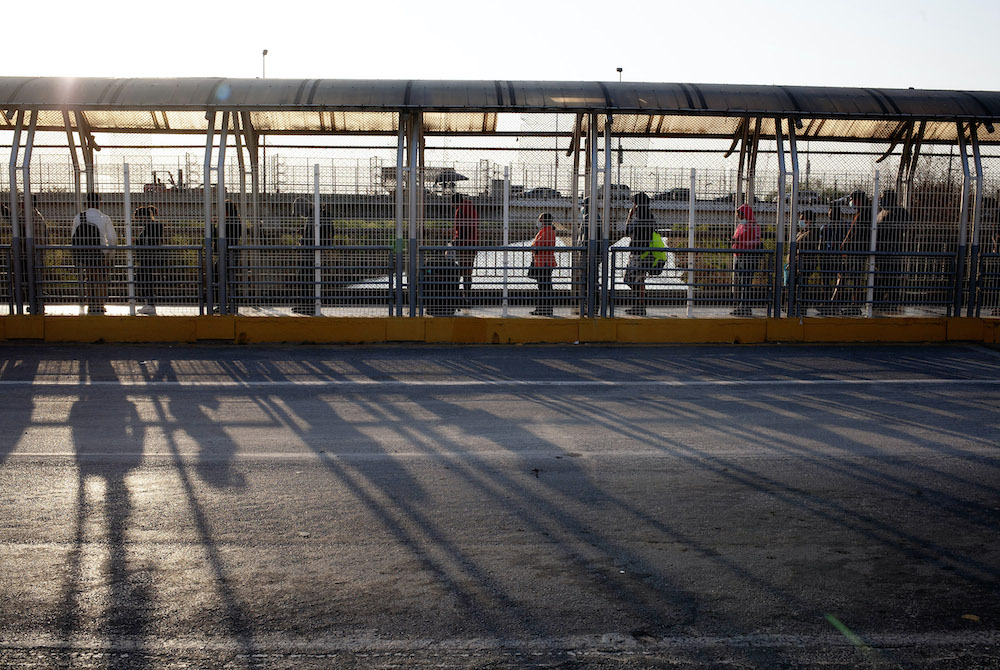
People authorized to cross the U.S.-Mexico border line up on the U.S. side of the McAllen-Hidalgo-Reynosa International Bridge early in the morning of March 22 in McAllen, Texas. At times, the line to get in stretches the entire length of the bridge, which means hours of waiting. (Nuri Vallbona)
For advocates for migrants and refugees, the response to incoming migrants at the border between the United States and Mexico is a source of emotional tension.
There is a sense of victory for the migrants and refugees who made it into the United States after months or years of uncertainty. However, there are also rising frustrations from potential asylees and activists spurred by the new U.S. presidential administration's lack of preparation and clarity regarding the ongoing expulsions of asylum-seekers.
President Joe Biden fulfilled a campaign promise once lauded among immigration activists when he ended the Migrant Protection Protocols, also known as the "Remain in Mexico" policy. The 2019 policy under former President Donald Trump forced more than 70,000 asylum-seekers to wait for their U.S. court dates in Mexican border cities.
But no concrete plan for asylum-seekers emerged in its place, so while thousands of migrants were able to enter the United States in triumph since Biden rescinded the Migrant Protection Protocols, others who have arrived at the border seeking asylum but who were not affected by the program are being expelled to Mexico.
"We do celebrate the progress that has been made," said Sr. Tracey Horan, a Sister of Providence of St. Mary-of-the-Woods, Indiana, and assistant director of education and advocacy for the Kino Border Initiative in Nogales, Arizona. "At the same time, it doesn't feel like the response that we're seeing is equal to the urgency that the people living it are feeling."
The driving factors that make migrants flee their homes are only adding up, she said: the usual violence and corruption are now met with destruction from hurricanes and extreme poverty as a result of the pandemic.
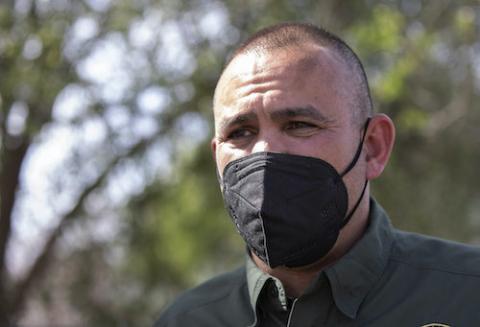
Chris Cabrera, vice president of the National Border Patrol Council (Nuri Vallbona)
U.S. Customs and Border Protection reported a 28% increase in migrant apprehensions for January and February, with more than 17,000 unaccompanied minors expected by end of March, an all-time high.
"The numbers, they have gone crazy," said Chris Cabrera, spokesman for the National Border Patrol Council. "I've never seen it this busy since I've been here, and I've seen it in some pretty busy times."
Biden's critics describe the surge as a "crisis" that belies political hypocrisy, given Biden's previous disparagement of Trump's migrant policies. Those who minister to migrants along the border, however, dismiss the word as an attempt to politicize what was a predictable situation.
In interviews with Global Sisters Report, many said that to consider these border crossings a "crisis" is disempowering and encourages short-term thinking in exchange for nuance regarding an effective humanitarian response.
But as activists detail the needs mounting along the border, they wind up describing what sounds like a crisis.
Ambiguity over action
Critics and advocates point to different causes for concern when assessing the border.
Immigration advocates bemoan the Biden administration's lack of transparency and clear plans for those who continue their months- or years-long wait to present their cases for asylum, as well as the continuation of the Title 42 policy, a public health order from March 2020 that allows the U.S. Customs and Border Protection to expel migrants to prevent the coronavirus from spreading in holding facilities.
Dylan Corbett, executive director of the Hope Border Institute, said the government is capable of handling the number of migrants currently crossing the border. U.S. Customs and Border Protection records show that a seasonal uptick in undocumented immigration is common for the spring, though the unprecedented number of unaccompanied minors posed unforeseen logistical challenges.
But any instability along the border is largely due to the government's "ambiguous response," said Corbett, who lives in El Paso, Texas.
Missionary of Jesus Sr. Norma Pimentel in McAllen, Texas, agreed, noting that a "crisis" indicates a shortage of options.
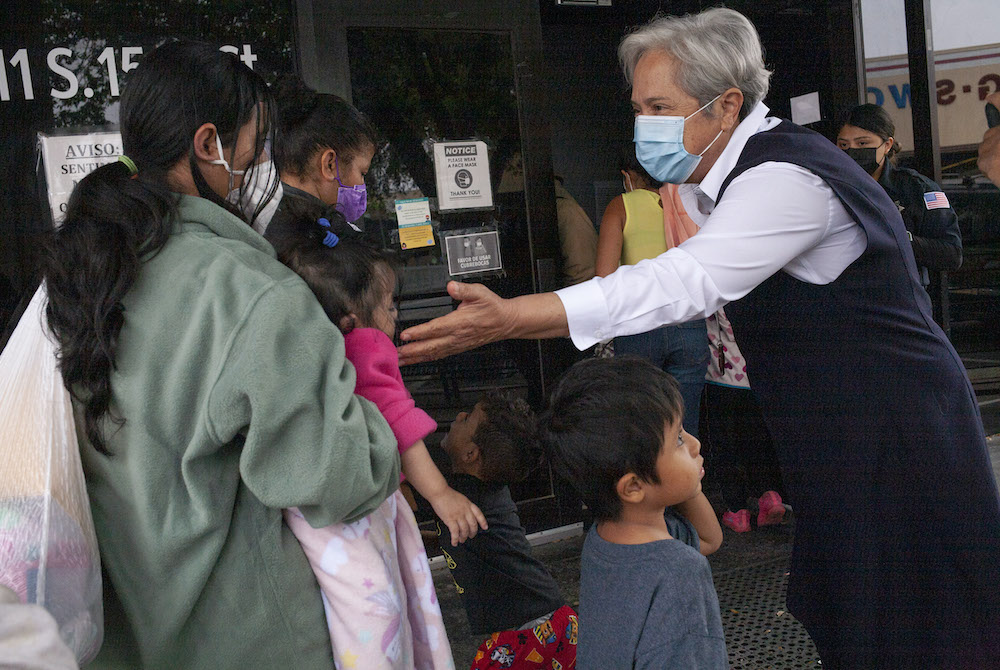
Sr. Norma Pimentel, a member of the Missionaries of Jesus and executive director of Catholic Charities of the Rio Grande Valley, greets newly arrived immigrants March 23 at the Humanitarian Respite Center in McAllen, Texas. At the temporary shelter, volunteers help make travel arrangements and coordinate COVID-19 testing before immigrants proceed to other parts of the United States. (Nuri Vallbona)
"But I think the options are there — they're just not being put forward," said Pimentel, executive director of Catholic Charities of the Rio Grande Valley.
She said she often wonders why national agencies aren't flocking to the border to offer humanitarian aid or facilities to increase processing capacities. Instead, help has come from the local community, such as Our Lady of Guadalupe Catholic Church in Mission, Texas.
"They make it sound like it's disintegrating into chaos, but here, it's working out beautifully," said Oblate Fr. Roy Snipes, pastor of the church. He was recruited during a conference call with Pimentel when she asked for help with the overflow from the Catholic Charities respite center.
Now, Snipes and his parishioners feed and shelter anywhere from 70 to more than 200 immigrants a night, which he considers "an honor."
Horan and Corbett affirm the importance of having local faith and border communities like Snipes' church that gladly fill the void in offering hospitality to migrants. But they also know that those same communities would prefer "the government to do their part to contribute," Horan said.
Corbett said he commends the Biden administration for taking some "positive steps" in the two months Biden has been in office, including reversing the "Remain in Mexico" policy and proposing legislation that prioritizes a focus on the root causes of migration over enhanced law enforcement.
But Biden is also continuing Title 42, and because this policy affects asylum-seekers from all over the world, Corbett said its impact could exceed that of the "Remain in Mexico" policy.
"We were shocked, morally outraged as a nation when the Trump administration did that to people," Corbett said of the deportations. "We need to turn that outrage into a plan for action, and we haven't seen that yet."
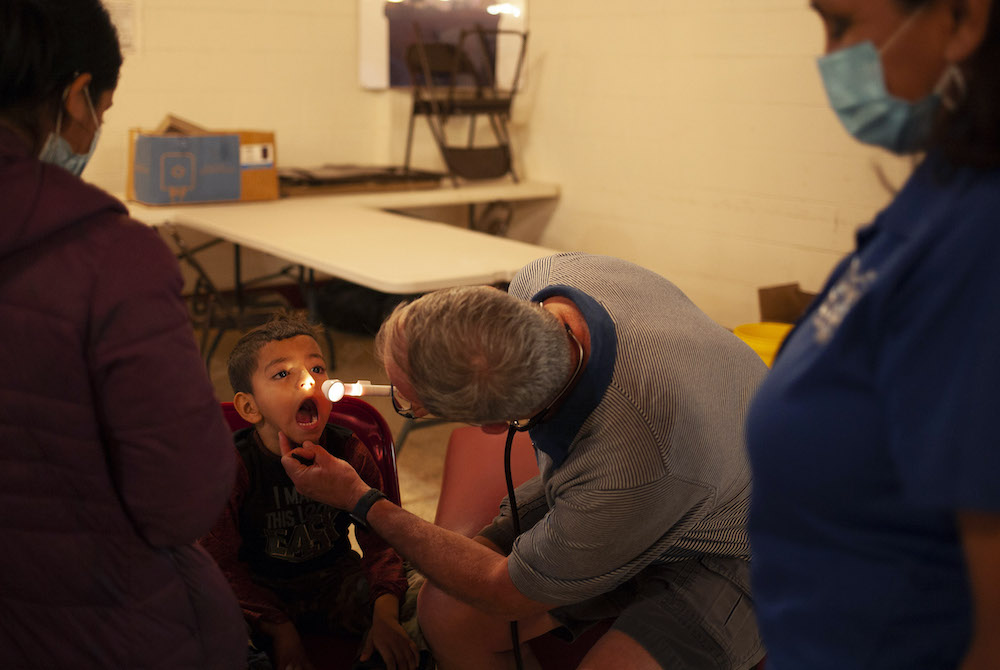
Dr. John Owen, second from right, of Liberty, Missouri, examines Wilmor Ariel, 5, of Honduras on March 22 at Our Lady of Guadalupe Catholic Church in Mission, Texas. The doctor, a parishioner who divides his time between Texas and Missouri, checked immigrants' health needs while they sheltered at the church after being released from immigration custody. (Nuri Vallbona)
Advertisement
At Kino Border Initiative, Horan works with recently expelled migrants, often helping them file complaints of human rights abuses. In those daily conversations, Horan said she sees "how disorienting and traumatizing" it is for them to be dropped off in Mexico without any documents or information on what comes next.
Biden's Department of Homeland Security, unlike Trump's, is not turning away unaccompanied minors at the border. Though the policy is intended to keep vulnerable children safe in the United States, it also tempts parents with the tough choice to send their children north without them.
"When I say 'children,' I'm not talking about 15 years old, 14 years old; I'm talking about 3, 5, 7 years old, completely by themselves," the National Border Patrol Council's Cabrera said, adding that he wouldn't have believed it had he not talked to the children himself.
Joanna Williams, executive director of the Kino Border Initiative, recalled a recent exchange she had with a mother and her teenage daughter, both of whom were fleeing violence from their Central American home. They were hopeful they would receive asylum in the United States but instead were promptly sent to Mexico.
The mother, aware that unaccompanied children had a better chance at gaining access to the asylum process, asked Williams if she thought she should send her daughter to the border by herself.
"That to me is such a heart-wrenching decision, and it's illustrative of the fact that there isn't access for protection for whole families," Williams said. "Especially from a Catholic perspective, we need to be promoting family unity in this immigration process. We don't need to be undermining it."
Straddling the border between Mexico and Arizona, the Kino Border Initiative ministers to individuals who have been stranded in Nogales awaiting protection, some for as long as a year and a half, as well as those recently deported from the United States. The faith-based organization offers food, clothing, medical assistance and programs for kids who have spent more than a year without access to education.
"Especially from a Catholic perspective, we need to be promoting family unity in this immigration process. We don't need to be undermining it."
—Joanna Williams, executive director of the Kino Border Initiative
The initiative also developed a partnership with the Florence Project, a nonprofit that offers legal services to migrants, to help individuals better understand their rights, which has been "extraordinarily difficult," Williams said: Because there is currently no legal access for asylum at the border, she said, "we're preparing people for a process that, at the moment, barely exists."
Her main critique of the current administration is its reliance on messaging, "overly convinced that if they tell people not to come, that's going to be an effective strategy," she said.
The administration underestimates the desperation of individuals who choose to embark on the dangerous journey north, she added. "People are making rational choices to try to protect their kids as best as they can."
Veronica Quevedo, for example, left Guatemala a month ago with her four children in tow. After a three-day stay in an immigrant camp, she and her children crossed the Rio Grande in a raft and turned themselves in to immigration authorities. She said she is unsure how much money she owes smugglers, but the money was "loaned" to her. She knows she has to pay.
"We left it at that," she said. "The money will be paid."
Now at Snipes' Our Lady of Guadalupe Church, Quevedo hopes to find work, to help her children get an education, and to land a court date and a lawyer who will help her receive asylum.
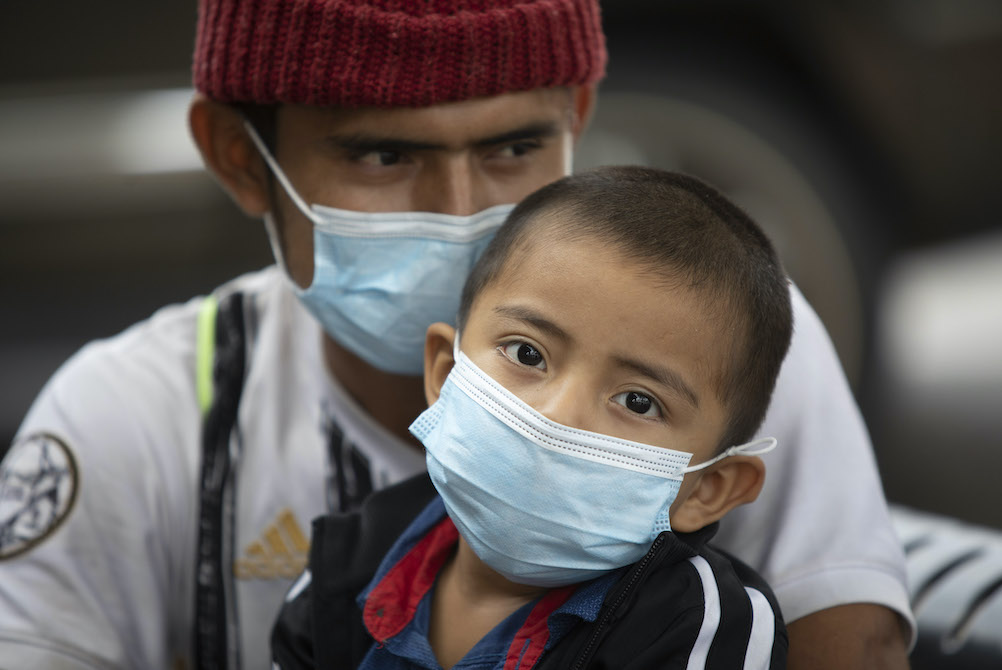
Jose, a Honduran immigrant who only wanted to be identified by his first name, holds his son, Taylor, 4, March 23 outside the Humanitarian Respite Center in McAllen, Texas. Jose described how a hurricane destroyed his home, leaving him and others unable to find work and food, which forced him to come to the United States. (Nuri Vallbona)
Williams said she considers the situation at the border an invitation for Catholics "to live out solidarity, an invitation to respect people's rights, an invitation to recognize the face of Jesus in the faces of people who are arriving."
"We are capable of welcoming asylum-seekers."
Pimentel has long been ministering to migrants who arrive at her respite center in McAllen shortly after their legal processing. The space currently looks more like a kindergarten, as half of the 500 people there are children.
It's a ministry that's as fulfilling as it is chaotic, as she and her staff work to organize the travel plans and basic necessities for all who pass through the Catholic Charities humanitarian center, including testing them for COVID-19.
Pimentel said she is worried that Texas Gov. Greg Abbott has politicized the migrant situation at the state level, criticizing the temporary facilities where migrants are detained and saying they have become super-spreader sites: On March 28, 50 out of 600 newly arrived migrants tested positive for COVID-19, and at least 100 were sent to area hotels to quarantine.
Pimentel said although Abbott appears worried about the spread of the virus, he hasn't allocated the funds to address it properly.
"That concerns me a lot, that a political decision can be used to try to make a point that the new government is failing to address the border issue," she said. "That's wrong, and it's really not working together to find solutions to address what's happening."
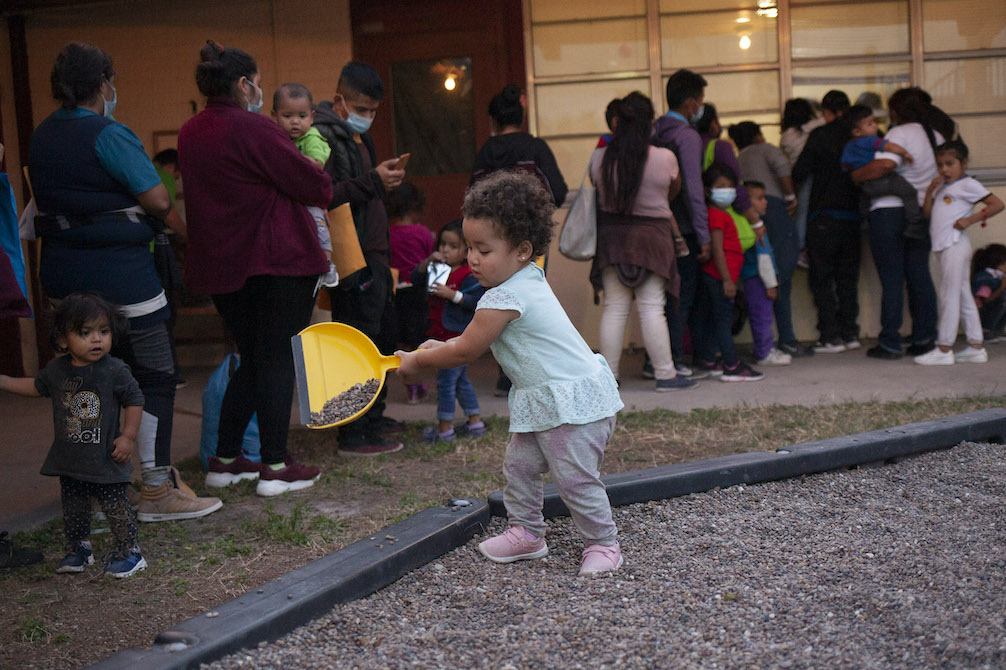
Luisa Rivera, 18 months old, of Honduras plays at the playground of Our Lady of Guadalupe Catholic Church in Mission, Texas, on March 22 while her parents and other immigrants line up to receive clothing. The church has been providing temporary overnight shelter on nights when the Humanitarian Respite Center is full. For the past month, anywhere from 70 to about 200 people have stayed at the church nightly. (Nuri Vallbona)
The best ways to respond
Advocates agree that the United States should work to stabilize the Northern Triangle —Guatemala, Honduras and El Salvador — so families don't need to become migrants or refugees at all. They are also clear about how the government can respond to the border's immediate needs.
As Horan put it: more health and human resources, fewer troops.
"What we don't need are more Border Patrol agents," she said. "What we need are social workers and asylum officers and judges, people to accompany these families through the legal process they have a right to."
Williams highlighted the need to reunite families separated by deportations as well as the need for more processing capacity, particularly at ports of entry. In making the official ports of entry more accessible, fewer migrants would choose to trek through the desert or hire smugglers, dangerous options they only choose because being turned away at the ports is so common.
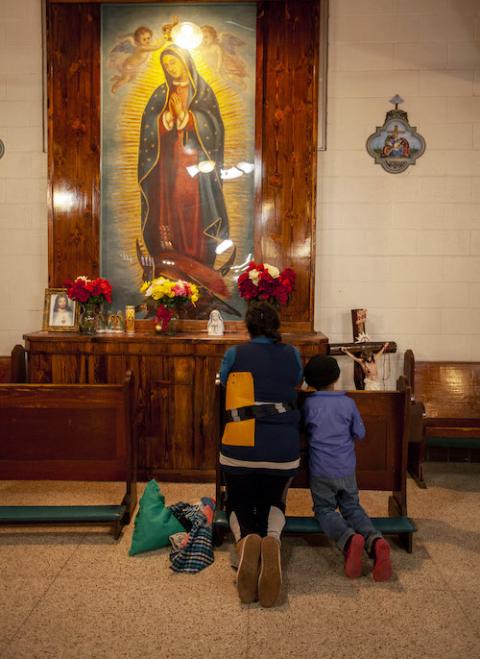
Blanca Paola Lopez Davila of Guatemala thanks La Virgen de Guadalupe for her safe arrival to the United States as her son, Carlos Fernando Rextun Lopez, 6, kneels beside her March 22 at Our Lady of Guadalupe Catholic Church in Mission, Texas. The pair spent eight months in Mexico trying to cross the Texas border. (Nuri Vallbona)
Corbett suggested demilitarizing the border as well as establishing a humanitarian presence that prioritizes those most vulnerable to the coronavirus, a system that processes asylum cases while the individual is still in his or her home country, and partnerships with international agencies that offer options for accessing asylum once they're in Mexican border cities.
"When you deport people from one point on the border to another 800 miles away, you're deliberately fomenting an unstable situation" instead of ensuring protection, he said.
Above all, the advocates are united in calling for a concrete plan for what comes next.
"People in Nogales would be willing to wait if they knew that they were waiting for something," particularly with regard to restoring asylum, Williams said.
Horan agreed, adding that simply having confirmation that it could be a month or a year before migrants reach their final destination brings some peace of mind.
Corbett said he has had positive experiences working with the federal government as they collaborate with nongovernmental organizations on the border, and he is optimistic that transparency and communication with border communities is possible.
"I don't want to diminish that these things are difficult, but I also don't want to diminish our ability as a country to make these obligations," Corbett said. "We can meet them."
[Nuri Vallbona contributed to this story from the U.S.-Mexico border.]

